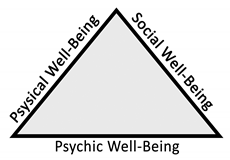Abstract
One of the main objectives of contemporary society and international research is to improve the physical and psychological health and well-being of the population, especially within the urban space. An effective approach to address this complex issue must necessarily be trans-disciplinary, and must be framed in the broader perspective of the Science of Sustainability, in particular the Psychology of Sustainability and Sustainable Development, as a frame of reference. The study shows the first results of research, in terms of methodology and qualitative analysis, with the following objectives—identification of the criteria for intervention for a healthy city design, with particular attention to the psychological, architectural, and construction aspects, and an initial verification of these criteria, through a case study consisting of a section of the city’s waterfront, in the city of Livorno. This case study has enabled, both, the definition of an innovative design and implementation of solutions, for the correct use, accessibility, and management of spaces. It provides the first evaluation of a possible digital analyses of a waterfront, before and after intervention; and highlights the potential and the critical aspects of the process of recovery and re-appropriation of an urban space, for a new social life, within it.
1. Introduction
The psychology of sustainability and sustainable development [,] constitutes a vital research area as a current contributor to the trans-disciplinary perspective of Sustainability Science [,,,]. The framework of the psychology of sustainability and sustainable development [,,] contributes to broaden the concept of sustainability, by not only considering the ecological and socio-economic environment but also by introducing a specific focus on the enhancement of the quality of life of individuals in different environments, including the natural and built environment [].
This perspective overwhelms the traditional definition of sustainability focused on avoiding exploitation, depletion, and irreversible alteration, while centering on an approach of promotion, in terms of enrichment, growth, flexible change, flourishment, and well-being. Psychology of sustainability and sustainable development [,,] calls for a complex vision regarding projects related to natural, personal, social, and organizational environments, also including the built environment. It then asks for reflexivity, meaning, and purpose for a sustainable development, and the well-being [,,] of people in their environments.
Good health and well-being represent one of the seventeen UNESCO Sustainable Goals [] for people to reach a good quality of life. The biopsychosocial model [], according to the definitions of ‘health’ by the World Health Organization [], underlines the passage of health from absence of illness to an optimal functioning. This approach is the basis for positive healthy societies, which also focusses on the importance of designing a healthy city that sustains well-being []. Using the lens of the psychology of sustainability, we can say that sustainability of the urban space requires city designs that helps the primary prevention of illnesses [,] and promotes the well-being of an individual, as a point of reference.
Even if, at first glance, land-use planning and public health might appear to be two very different fields, numerous research work has illustrated the effects of living spaces on emotional states (from the psychological point-of-view) starting from the analysis of various critical issues affecting the places where one lives, works, and moves [,,].
Economic well-being, especially in Europe and North America, has grown steadily since the Second World War, contrary to the degree of satisfaction and the psychophysiological well-being of the person. Added to this is the perception of little security, a sense of not-belonging, and a feeling of abandonment, in the individual, with a limited ability to trust others. Thus, it disregards the ability of the European city to be a witness to the values of ‘civitas’ of the Enlightenment, where human rights and freedom grew stronger []. In the urban life, the increase in chronic diseases caused by pollution and sedentary lifestyles are also important. To make up for this, public administrations have developed intervention policies which, in addition to controlling the environmental quality, aim to stimulate physical activity through the design of service infrastructures, such as green areas, or fitness and pedestrian paths []. There is no doubt that the development of chronic diseases is one of the most significant public health problems in the 21st century []. While many types of diseases have been primarily understood in terms of individual risk factors, there have been some well-known attempts to contextualize diseases within an environmental framework. Changing the behavior of individual isolation might be more difficult than modifying the environment that facilitates and promotes them. If, in the past, the main focus was on ensuring hygiene and comfort, both in the city and in the individual building, today the excess of comfort has transformed the symbols of innovation of the last century—for example, elevators in buildings, or the use of private cars even for small movements—into environmental factors that contribute to the onset of diseases, due to inactivity and a sedentary lifestyle, such as obesity (Figure 1) and diabetes [].
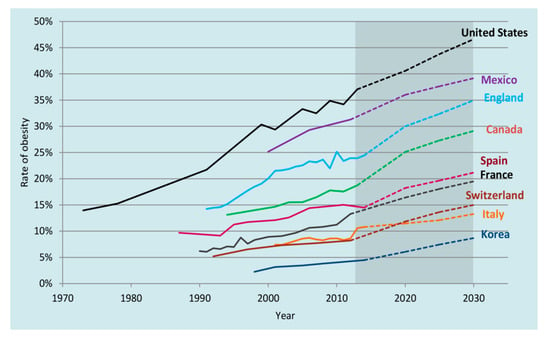
Figure 1.
Projected rates of obesity. The Organisation for Economic Co-operation and Development (OECD) projections show a steady increase in obesity rates, until at least 2030. Obesity levels are expected to be particularly high in the United States, Mexico, and England. On the contrary, the increase is expected to be weaker in Italy and Korea, with obesity rates projected to be 13% and 9% in 2030, respectively. Obesity rates are projected to increase at a faster pace in Korea and Switzerland, where rates have been historically low. Obesity is defined by Body Mass Index (BMI) ≥30 kg/m. OECD projections assume that BMI will continue to rise as a linear function of time. Source: OECD analysis of national health survey data. www.oecd.org/health/obesity-update.htm © OECD 2017 [].
It is, therefore, evident that the health of the population, as well as that of the planet, will be strongly conditioned by the life systems in the cities. In this context, The Healthy Cities (WHO) project, promoted by the World Health Organization (WHO), at an international and long-term level, consists of the implementation of global strategies that are locally adapted, to protect the health of a city’s inhabitants and to promote a sustainable development, through a process of political engagement, institutional change, capacity building, and planning, based on partnership and innovative projects [,].
This project is to be achieved through some fundamental actions, such as creating a favorable environment for humans, ensuring basic sanitation with access to health care, and improving the quality of life, objectives that could be implemented by allowing the person to be in contact with nature and have proper nutrition since childhood, with a minimal use of the car. This implies the necessity to have a direct connection between the main poles of ordinary life, such as school, work, gym or retail stores, and therefore, favor the development of a correct urban form.
The impact of landscape design on chronic diseases is often discussed by comparing different types of urban design and assessing their different impacts on public health. In this context the question to be asked concerns the role of the designer who, from the urban to the architectural scale, can be decisive. The designer will have to promote movement, both, in the open air, through the project of neighborhoods, roads, and open spaces that favor a slow-pace mobility, and in the realization of active buildings that stimulate the physical activity of people. To allow this, in the design of public space, the measures to be taken focus on the design of accessible pedestrian streets with high connectivity, traffic reduction, attention to the landscape, lighting, rest areas, presence of water and fountains, but also on the development of continuous cycle networks. Therefore, an active design is also of considerable importance, not only for public health but also for the environment; a similar design with such prerequisites, would promote physical activities, such as walking instead of driving, the use of stairs instead of elevators and outdoor activities. However, design sensitivity should generate an overall organic reasoning that not only takes into account new interventions, but also evaluates the testimonies of the past during the redefinition and regeneration. In cities, in fact, there are often places that, having lost their original function or because they have become marginal and peripheral compared to the centers of interest, get abandoned []. Very often these are spaces of considerable historical and architectural importance that, with an adequate recovery, can be saved from their oblivion and be actively used by the population, again. In this framework, a correct design has as the fundamental objective of guaranteeing the conditions of well-being for an individual by establishing him as an instrument of mediation between himself and the environment, for the determination of the optimal conditions of life, such that it refers to the design activities in the most experiential, immersive, and dynamic aspects.
2. Principles for Designing Healthy Cities
Starting from the definitions of city, health and design, an attempt was made to outline a general framework of study, with the aim of improving human life and the relationship it has, both, with itself and with others and nature. These considerations lay the foundations for the definition of design guidelines that will be applied to the case study—the redesign of a part of the waterfront of the city of Livorno (Italy).
Today, the main problems of the city concern with a lack of security, and a sense of non-belonging and abandonment []. The environment has become anonymous, especially in the suburbs, where the places of aggregation and socialization are almost completely absent. To improve man’s psychophysical balance we need to encourage communication, build the suburbs, on a human scale, to bring services closer together and create safe neighborhoods. An effective response can also be given through the use of design, both, as a means of crime prevention and as a means of encouraging well-being; design as an instrument that can be used by policies that support an increase in the duration of old-age lived in good health []. Human well-being is the main center of this reflection, which translates into various aspects—from the physical to the emotional to the social (Table 1).

Table 1.
Design requirements for defining public spaces with a balanced well-being for the individual.
The enormous development of the city has expanded the urban spaces so much that it has attracted on itself mechanical means of communication that have enormously changed the relationships of life in the city. Nowadays we are faced with an urban planning of cities, where the human constant of social life has completely vanished, creating urban structures far from the neighborly, human relationships, which disseminate its functions and activities at considerable distances. Distances that have required a level of complex mobility, such as the car, humiliating the natural way of achieving the objectives with the human force only, i.e., walking. The latter always puts forward innovations in the transfer, a level of low-pace mobility, free to stop at any point and creative in the choice of the route, unlike the levels of fast mobility which is necessary to unite the dilated spaces of the city—forced and imposed by the arteries of communication. It follows that roads, no matter how large, are built to meet mechanical displacements, to the detriment of the slow pedestrian movement, with the consequence of large roads, pedestrian areas, and narrow sidewalks. On the other hand, the mobility of the new city, evolved from the historical city, is built around the use of the car and everything that deviates from this type of movement is an economic compromise that is made of delays and times to be respected.
In the project of the new city, the places of relationships are reduced to the minimum, to make room for huge parking areas, and the life that was previously carried out in open areas, is segregated and pushed into large buildings, such as shopping centers, gyms, and multiplex cinema, which have now replaced outdoor life. With this method, social interaction is replaced by isolation, which leads to the loss of a sense of community and, thus, creates sedentariness in the individual—usable spaces are appreciated only if they are easily reachable by car and not by feet. Therefore, it is necessary to define a city as an active means to determine its use by its inhabitants. Some studies showed that a positive relationship between physical activity and subjective well-being is moderated by extraversion and by openness to experience [], so designers can encourage physical activity by designing spaces and roads that encourage walking, cycling, and other recreational activities. All of this involves improving both an individual’s health and the qualities of the environment. A distribution of this sort determines a connected city that is characterized by a mix of land uses and a system of public viability that tends to increase physical activity among the city residents, leading to an increase in active transport such as walking, and use of bicycles or public transport [,,]. Active leisure opportunities can be created that are more accessible to children and their families, through the organization and location of parks, playgrounds, and squares can also be created. It is also possible to promote greater access to healthy foods through the supply and positioning of food markets in the neighborhood, including farm-to-table markets. Many of these active design strategies improve not only the health of the population, but also the environmental sustainability. There are many virtuous examples of municipalities and organizations which provide strategic projects and intervention guides to obtain active and healthy cities [,,,,].
The rediscovery of pedestrianism as an essential component of urban mobility—a well-established acquisition in the debate on the sustainable city that is reflected in numerous documents, guidelines, and lines of action of the European Union—has allowed us to go beyond the old models of city development that are oriented towards the use of car, a model inherited from the recent past; urban space is, therefore, lived, crossed, and traveled in an active way, even with positive repercussions on the reduction of urban pollution levels [,].
It emerges, therefore, that sustainable planning, which favors a better use of the territory and that promotes, both, the health of the environment and that of people, can be realized through the observation of the following cornerstones:
- creating opportunities and choices for housing;
- creating neighborhoods suitable for pedestrians;
- encouraging the community and parties involved in the collaboration;
- encouraging community characteristics and attractions with a strong sense of place;
- making predictable, fair, and cost-conscious development choices;
- mixing the soil functions;
- preserving open spaces, agricultural landscapes, natural beauties, and critical landscape areas;
- creating a variety of transport choices;
- strengthening a direct development among existing communities;
- taking advantage of the compact building project.
An analysis of WHO strategies for the definition of Healthy Cities [], ‘A healthy city is one that is continually creating and improving those physical and social environments and expanding those community resources, which enable people to mutually support each other in performing all the functions of life and develop to their maximum potential’ [], lets us achieve a strengthening of the operational declination through the lenses of the psychology of sustainability and sustainable development [,,]
It emerges that the final goal of health improvement is achieved through some fundamental actions:
- creating a favorable environment;
- guaranteeing basic sanitation and access to health care;
- improving the quality of life.
The important and recurrent points of this strategy are:
- being in touch with nature and having the possibility of access to beaches, rivers, lakes, etc.;
- proper nutrition since childhood;
- a minimal use of the car.
This confirms what has already emerged in scientific literature, namely the need to have a direct connection between the main poles of ordinary life (school, work, gym, retail stores) and to encourage the development of a correct urban form, thanks to a reduction of air pollution and an improvement in human health (with the consequent reduction of obesity, diabetes, and heart attack problems).
For a healthy city the coexistence of several elements is, therefore, necessary. These include, adequate political strategies, the desire for social change, both by the citizens and by institutions, and the union of several forces that have the same objective.
In this context a new model of city has been outlined—the inclusive city. This is welcoming and accessible to all, with a better active transport and the spread of areas to encourage physical activity and aggregation (green spaces, cycle-pedestrian tracks, areas for skateboards, paths and trails, sports facilities).
The presence of greenery and environmental sustainability are two concepts that are now assuming an increasingly important role in architectural and urban planning. Suffice to say, green is no longer found only on the ground, but has even reached the envelope of buildings, coverings, and facades [,]; sustainability is found in the method of building, in the use of specific materials and in the exploitation of renewable energy []. In this framework it will be necessary to find a corresponding project that elaborates the above-mentioned principles of a healthy city design. This can be achieved through a comparison of, the relationship between the built-up and green areas in the project, the integration of the planned and existing new functions, the accessibility of the routes in project, the pedestrian and cycle paths, and their ability to stimulate active lifestyles, through the verification of parameters that take into account the relationship between the path and the calorie consumption of individuals on the basis of the distance traveled and the speed of travel.
The well-being of the inhabitants consists of a psycho-physical state, both, mentally and corporally, in a socio-economic balance, and in the care of the environment [,]. This sense must spread from the individual citizen to his own home, up to the urban context, whose fundamental elements are natural ones, understood as the real nature and the social ones, i.e., the identity of the place.
3. Materials and Methods
The research work, following the analyses carried out, provided elaborated guidelines for an architectural design, both on an urban scale (illustrated in this paper) and for a single building (Table 2).

Table 2.
Main themes that affect the planning for well-being.
The variables that are fundamental for an analysis of the relationship between urban planning and mobility models were identified as density (concentration of jobs and people in a given urban area), diversity (the number, variety, and balance of land use in the territory) and design (the characteristics of the road and road network of a district) [], in addition to the destination (the ease of reaching a central business district or another area of concentration of jobs and attractions), and the distance (measure of the average distance from home or work to the nearest train station or bus stop). Keeping the above in mind, it was possible to summarize the basic principles of an active city:
- modeling urban space in order to promote physical activity;
- differentiating land use (housing, services, and commercial activities);
- concentrating local services, retail, installations, and transit;
- increasing the use of public transport and active transport;
- preparing safe routes and installations for pedestrians and cyclists;
- connecting neighborhoods to neighboring cities, through road networks;
- maintaining a high quality of urban space that invites and celebrates daily activities;
- creating opportunities for recreational activities by designing parks and places for physical activity;
- designing and building spaces for physical activity;
- giving all citizens the opportunity to be active in everyday life.
Subsequently, design guidelines have been drawn up to present strategies for the design of neighborhoods, roads, and open spaces that favor transport and various recreational activities, including walking and cycling (Table 3).

Table 3.
Design guidelines for the definition of active urban spaces.
The main recommended measures include:
- development and maintenance of the mixed use of territory, in the neighborhoods of the city;
- improvement of access to squares, parks, open spaces, and recreational facilities, and design of these spaces to maximize their active use;
- improvement of access to full service of food and fresh food stores;
- design of accessible pedestrian streets with high connectivity, traffic reduction measures, landscape, lighting, benches, water, and fountains;
- facilitation of cycling for recreational activities and transport, through the development of continuous cycle networks and the integration of secure outdoor and indoor bicycle parking infrastructures.
In this framework, it was possible to go beyond the traditional boundaries, like thresholds that divide one space from the other, the inside from the outside, the private from the public; the aim was to create dynamic boundaries that were not limited to a divide between the two entities but rather react to human activity, and might even require its interference to be activated. From this point of view, “designing well-being” defines a new way of thinking and perceiving both public space and architecture, making them both active for improving the well-being and quality of life of human beings.
4. The Case Study
This research, characterized by a strong design approach, analyzes a case study related to a section of the current waterfront of the city of Livorno []. The area of study, also because of its historical genesis, presents a very heterogeneous aspect, in which different realities of different ages and functions alternate and coexist; this lack of homogeneity is one of the motivations for which this site was chosen for design reflection; along the route, residential areas alternate with bathing areas, shelter areas for boats, and areas of tourist and sporting interest. The relevance of urban transformations in the historical areas of the city’s waterfront, in recent years, has opened new perspectives for research on risk conditions, anthropic pressures, and design opportunities in this area. Analyzing and interpreting a waterfront, as a complex context, requires an assessment of the identities of a social, cultural, and economic community, being a catalyst for cultural experiences and activators of urban values. In this context, the waterfront is a useful study model for research carried out to verify design guidelines of the healthy city design, in terms of defining an innovative design and implementing solutions, for the correct use, accessibility, and management of urban space.
The research was then divided into three thematic areas linked from a logical and methodological point-of-view. The first, concerned the analysis of the current state of the area, the second led to the redefinition of the area, and finally the third, verified the congruency of the project, with the principles of a healthy city design. The initial phase of the study focused on the main problems of the area, through a cognitive framework that was drawn-up, following the analyses carried out in the field. This has been listed below (Figure 2), according to the classes of needs identified by the UNI 8289/1981 standard. It defines the classification criteria for the definition of necessary classes, which can be conceived as an explanation of the needs of end users, evaluated according to environmental, cultural, and economic factors. These can be contextualized, as follows, for this case study:
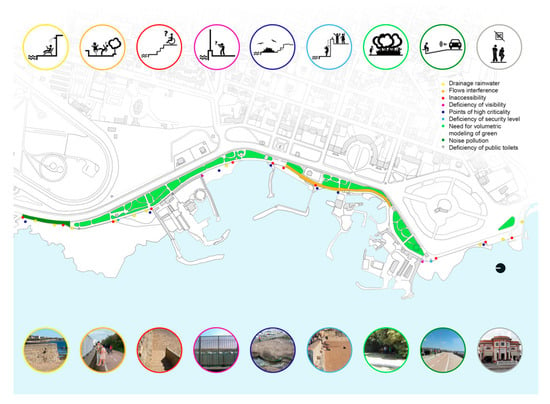
Figure 2.
Plan of the cognitive framework with the main critical issues.
- difficult accessibility to the coastline;
- lack of safety level for the parts placed at different altimetric levels, with risk of falling objects and people, from above;
- high levels of noise pollution, due to the presence of coastal vehicular traffic;
- difficulty in the flow of urban meteoric water towards the coastline;
- lack of visibility from the city towards the sea, due to the occlusion of the seafront stretches by the bathing establishments;
- lack of public toilets;
- need to model and control existing green areas;
- interference between the paths of different natures, such as pedestrian and cycle paths.
These critical issues hinder the correct usability of the area, making the waterfront not very inclusive. These issues are common to other similar cases, both in the coastal area and not, and in general where there is a public space with the presence of an element of excellence to be enjoyed—be it a park, the bank of a lake, or a river, or a significant architectural complex.
The second phase, with the subsequent design hypotheses, had the objective of improving the critical issues that emerged during the cognitive framework, favoring the accessibility of the area and its attractiveness. The new routes are located with new piers at sea level, and has an arrangement of thematic public spaces with new functions. All of this is to increase the offers that a promenade can give to the citizen, such as the possibility of realizing areas equipped for outdoor physical activity and building modules with special functions, including new public toilets.
The concept of urban usability is conceived, today, as the field of forces on which the spatio-temporal relations and the structure of the city can be regulated, allowing and encouraging both free movement and full access for, both, physical and psychological well-being. Usability must be understood as an immediate and total usability of the built space, giving back to the user, the management of their time [,]. The European Union is also committed to making Europe’s cities healthy, attractive, and sustainable, and to improving the citizens’ quality of life, now and for the future, by defining the main indicators for making its cities, attractive and sustainable—clean and healthy, green and pleasant, efficient and sustainable, and well-managed and democratic []. On this double criterion usability/attractiveness, it would be possible to make the waterfront of Livorno a plural identity, so that it is no longer a line, but is instead a network of places, functions, grafts, and reconnections between the coast and the city, between port activities and urban activities, also with cultural and recreational functions that are added to those already present.
In the third phase, the design reflection was analyzed to find a match for the principles of a healthy city design. Initially a functional analysis was carried out (Figure 3). The project actually contains areas of different functions to make it usable for different types of users, in particular the commercial area is privileged, as a source of income, and this has enabled the creation of free services for the community, such as co-working and fitness areas. The existing restaurant areas are well-maintained, as they are a reference point for the community, while those in the project have different characteristics.
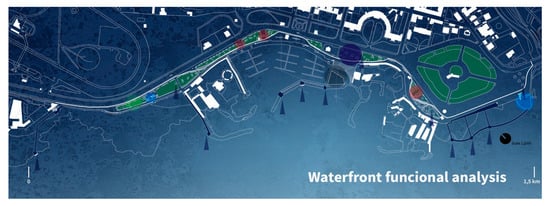
Figure 3.
Analysis of the distribution of services in the project state.
The waterfront provides for the creation of a new pedestrian path and also serves the function of filtering and accessing the nearby main roads and areas of interest of the city (Figure 4). Access to the sea from this route takes place on two distinct levels—with descents (some located in existing points and others newly designed, with ramps, to grant access to the sea, even for people with disabilities), and through the piers (extension of the path to the sea that ends with small squares that serve as strategic vantage points). It is to be noted that access from the sea and from the hinterland, in many cases, are placed corresponding to each other, to guarantee a correct organization of the flows and possible escape routes. Lighting is an important element for public space, both, as an element of perception of space and of accessibility and security, even at night, preventing the possibility of degradation and vandalism. In the planning hypothesis, this is established by solar energy lamps that guarantee a diffused lighting, accompanied by recessed LED spotlights that form a trace for the pedestrian paths. In total, in the project, for each square meter there should be two square meters of fitness area, two square meters of catering, about three square meters of co-working, just under four square meters of areas intended for outdoor performances, and about six square meters of commercial areas. Since the project area is located in a strongly urbanized area, it was decided that the covered area would be reduced to a minimum, favoring green areas, instead, to minimize the environmental impact and to not shield the coastal landscapes. In fact, the project is expected to increase in-built surfaces compared to existing ones, by about 6.4%, where for each square meter of newly built areas, there are about ten square meters of green space (Figure 5, Figure 6 and Figure 7). The entire length of the route is further divided into areas with a different function; there are areas where parking is privileged, sections where the user is encouraged to transit, and others where it is possible to integrate the flooring with new green areas. This differentiation can be obtained as a result of the flooring, starting from a basic module, composed of 50 × 50 cm slabs and 200 × 10 cm planks in travertine; the transit area is obtained by completely tiling the path, the other areas, however, are obtained by replacing some elements of the paving with green areas or concrete blocks that act as a seat. In this way, the continuity of the route is guaranteed by the basic module and at the same time the user is encouraged to completely cover the area, thanks to the different points of attraction.
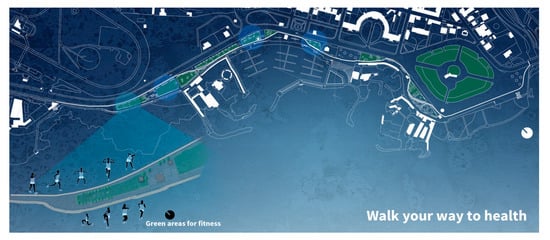
Figure 4.
The new wellness path with fitness areas.
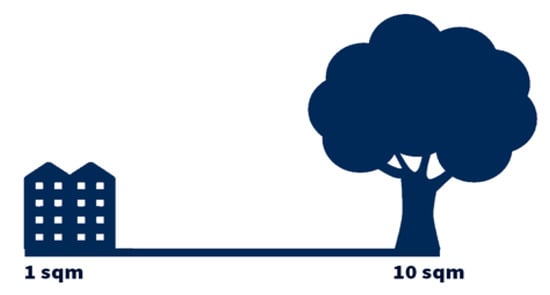
Figure 5.
Comparison between the building and the green areas. Since the project area is located in a strongly urbanized area, it was decided to reduce the covered area to a minimum, favoring the green areas, instead, to minimize the impact and keep the coastal landscapes free from shielding.
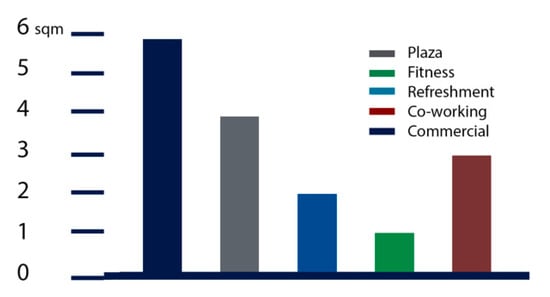
Figure 6.
Comparison of the expected functions. The project contains areas of different functions to make it accessible to different types of users, in particular the commercial area was privileged as a source of income and this enabled the creation of free services for the community, such as working and fitness areas. The existing restaurant areas were well-maintained, as they are a reference point for the community; while those in the project will have different architectural characteristics.
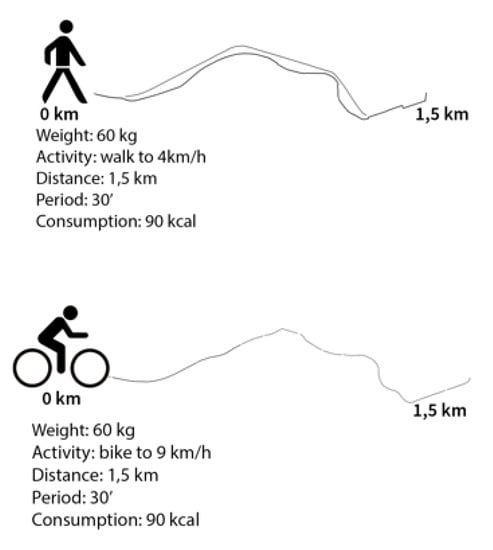
Figure 7.
Verification of the planned, pedestrian and cycle paths through the parameters identified by the design guidelines. Maintaining an average pace of 4km/h, the body tends to burn reserve fat (about 40% of calories burned), while when going at a higher speed, the body tends to burn carbohydrates and percentage of fat reserves falls to around 20%. The data concerning the caloric consumption are reported based on the distance travelled and the speed.
5. Discussion
The results of the research showed that a possible design strategy for the case study should restore harmony to such a disordered and incoherent set of elements. It would be necessary to confer attractiveness to a site with an enormous potential, through the inclusion of commercial activities and entertainment, for the various phases of the day, and at the same time the problem of accessibility, and more generally of the usability of the area, with pedestrian and cycle paths, and with the adaptation of descents to the sea, so as to re-establish the direct relationship between the city and sea, which is sometimes compromised. The planned interventions, which were developed along the entire length of the coastal strip under study, were those concerning usability, with the reorganization of the cycle path, to minimize crossings and the pedestrian crossing paths. The latter should be re-evaluated in terms of the safety of the treading surfaces, which often resulted in disjointed or disconnected, and was enriched with information totems, to make the relationship with the functionalities of the sea-side, clear and perceptible. A concrete solution to the problem of accessibility to the sea, identifiable in the descents to the sea—the difficulty of use for motor-impaired passengers—could be to think of new systems of ramps and stairs. These should also removable, to be connected to new docks that allow easy access to the water-level. This aspect, as well as acting on accessibility, would also improve the attractiveness of places, extending the access to bathing to other groups of users.
On the double criterion of usability/attractiveness, it would be possible to make the waterfront of Livorno a plural identity, a place from polysemy, so that it is not a line but is a network of places, functions, grafts, and reconnections between the coast and the city, between port and urban activities, with additional cultural and recreational functions. It could, therefore, be designed to upgrade the existing structures and services, by extending the existing the small marina, which would also be an opportunity to restore the compressed areas, from the environmental point-of-view, to the construction of new walkways on the existing cliffs, equipped with parking areas. In the design area of the project, attention has been focused on the possibility of exploitation in summer and in winter, by citizens and tourists, who can keep fit by practicing outdoor motor activity. The waterfront of Livorno is, thus, an excellent place to do these daily activities, thanks to the multi-level routes, areas for running and cycling without interference, and areas where you can also practice a slow walk, encouraged by the presence of the piers, the panorama, and the various services arranged along the route. These activities can help to stimulate the subjective well-being (psychological and physical) of the human, especially so, in the cases of older adults [,].
In conclusion, the project solves the problems of the waterfront by enhancing the merits of the area and triggering, in the immediate future, virtuous mechanisms to increase the value and economy of this part of the city. With the provision of new diversified services, ranging from commercial to catering, it is possible that investors can use the area, throughout the day and year. The various commercial areas also allow the inclusion of free services for the community, such as a fitness area, a theater on the sea, and co-working areas. All of these different functions are uniformly distributed throughout the territory, to create more attractive poles for users, who are, thus, directed to go through the entire project area, a positive aspect, both, from the point-of-view of wellness and the economy of new commercial funds, to which a greater visibility is guaranteed. Ultimately, the project is a complex system of organization of space, ranging from urban-scale planning of flows, to the architectural scale of new buildings, and to the design of urban design components; all this, therefore, contributes to create a place of high architectural and functional value for the territory, the users, and the public administration.
6. Conclusions
Designers play a decisive role in the planning of urban spaces, contributing to the health and well-being of the population, in order to prevent the growth of diseases, increasingly understood today as epidemics, such as obesity and chronic diseases related to bad lifestyles, such as a sedentary lifestyle. In this context, the impact of design on physical activity and, more generally, on active lifestyles, is crucial; placing itself as a project goal of the structures where there are different functions, which are connected in an organic manner with various levels of urban mobility, to achieve psychological and physical well-being of the user by favoring the possibilities and opportunities for movement. The case study—which is highly specialized, considering the complexities inherent in a waterfront—solves the problems of a specific area, enhancing its merits, but finding points of analogy and similitude with the problems of urban and architectural space, in general. The improvements made were spread over various fronts, from the plant design to the aesthetic, to an upgrading of abandoned areas, with the design of new buildings, spaces, and paths that allow a proper division of mobility levels, and at the same time, becomes an element of stimulation for the movement of people, by re-introducing the cardinal elements for the active design of a healthy city. In the framework of the psychology of sustainability and sustainable development [,,], taking care of the design of a healthy city means actively answering a primary preventive perspective [], to promote the well-being and quality of life of each human beings, in a sustainable environment [,,,,].
Author Contributions
Conceptualization, E.L. and G.S.; Methodology, E.L. and G.S.; Validation, E.L. and G.S.; Formal Analysis, E.L. and G.S.; Writing-Original Draft Preparation, E.L. and G.S.; Writing-Review & Editing, E.L. and G.Santi.
Funding
This research received no external funding.
Conflicts of Interest
The authors declare no conflict of interest.
References
- Di Fabio, A. The psychology of sustainability and sustainable development for well-being in organizations. Front. Psychol. 2017, 8, 1534. [Google Scholar] [CrossRef] [PubMed]
- Di Fabio, A. Positive healthy organizations: Promoting well-being, meaningfulness, and sustainability in organizations. Front. Psychol. 2017, 8, 1938. [Google Scholar] [CrossRef] [PubMed]
- Rosen, M.A. Towards energy sustainability: A quest of global proportions. Forum Public Policy Online: J. Oxf. Round Table 2009, 2008, 1–20. [Google Scholar]
- Dincer, I.; Rosen, M.A. Exergy: Energy, Environment and Sustainable Development; Elsevier: Oxford, UK, 2007; ISBN 978-0-08-097089-9. [Google Scholar]
- Di Fabio, A.; Rosen, M.A. Opening the black box of psychological processes in the science of sustainable development: A new frontier. Eur. J. Sustain. Dev. Res. 2018, 2, 47–52. [Google Scholar] [CrossRef]
- Komiyama, H.; Takeuchi, K.; Shiroyama, H.; Mino, T. Sustainability Science: A Multidisciplinary Approach; United Nations University Press: Tokyo, Japan, 2011. [Google Scholar]
- Rosen, M.A. Sustainability: A crucial quest for humanity—Welcome to a new open access journal for a growing mutidisciplinary community. Sustainability 2009, 1, 1–4. [Google Scholar] [CrossRef]
- United Nations. Sustain Development Goals: 17 Goals to Transform Our World. Available online: http://www.un.org/sustainabledevelopment/development-agenda/ (accessed on 11 June 2018).
- Engel, G.L. The need for a new medical model: A challenge for biomedicine. Science 1977, 196, 129–136. [Google Scholar] [CrossRef] [PubMed]
- World Health Organization (WHO). 1947. Available online: http://www.who.int/bulletin/archives/en/ (accessed on 4 December 2018).
- Di Fabio, A.; Kenny, E.M. From decent work to decent lives: Positive self and relational management (PS&RM) in the twenty-first century. Front. Psychol. Sect. Org. Psychol. 2016, 7, 361. [Google Scholar] [CrossRef]
- Hage, S.M.; Romano, J.L.; Conyne, R.K.; Kenny, M.; Matthews, C.; Schwartz, J.P.; Waldo, M. Best practice guidelines on prevention practice, research, training, and social advocacy for psychologists. Couns. Psychol. 2007, 35, 493–566. [Google Scholar] [CrossRef]
- Zhang, X.; Bayulken, B.; Skitmore, M.; Lu, W.; Huisingh, D. Sustainable urban transformations towards smarter, healthier cities: Theories, agendas and pathways. J. Clean. Prod. 2018, 173, 1–10. [Google Scholar] [CrossRef]
- Yannick, J. Architectural lessons from environmental psychology: The case of biophilic architecture. Rev. Gen. Psychol. 2007, 11, 305–328. [Google Scholar] [CrossRef]
- Wölfflin, H. La Psicologia Dell’architettura; Fornari, D., Scarpa, L., Eds.; et al: Milano, Italy, 2010; ISBN 9788864630069. [Google Scholar]
- Romano, M. La Città Come Opera D’arte; Einaudi Editore: Torino, Italy, 2008. [Google Scholar]
- Santi, G.; Cutini, V. Una Città in Movimento. Architettura, Spazio Urbano e Mobilità a Pisa; Pacini Editore: Pisa, Italy, 2015; pp. 21–25. [Google Scholar]
- Moneiro, C.A.; Moura, E.C.; Conde, W.L.; Popkin, B.M. Socioeconomic status and obesity in adult populations of developing countries: A review. Bull. World Health Organ. 2004, 82, 940–946. [Google Scholar]
- OECD. Obesity update. Available online: www.oecd.org/health/obesity-update.htm (accessed on 4 December 2018).
- WHO (World Health Organization, Urban Green Space Interventions and Health) Regional Office for Europe. A Review of Impacts and Effectiveness; WHO: Copenhagen, Denmark, 2017. [Google Scholar]
- Rosen, M.A. Engineering and sustainability: Attitudes and action. Sustainability 2013, 5, 372–386. [Google Scholar] [CrossRef]
- Magris, M.; Benjamin, W. Immagini di Città; Einaudi Editore: Torino, Italy, 2008. [Google Scholar]
- Marsh, C.; Agius, P.A.; Jayakody, G.; Shajehan, R.; Abeywickrema, C.; Durrant, K.; Luchters, S.; Holmes, W. Factors associated with social participation amongst elders in rural Sri Lanka: A cross-sectional mixed methods analysis. BMC Public Health 2018, 18, 636. [Google Scholar] [CrossRef] [PubMed]
- Chan, B.C.L.; Luciano, M.; Lee, B. Interaction of physical activity and personality in the subjective wellbeing of older adults in Hong Kong and the United Kingdom. Behav. Sci. 2018, 8, 71. [Google Scholar] [CrossRef] [PubMed]
- Frank, L.D.; Andresen, M.A.; Schmid, T.L. Obesity relationships with community design, physical activity, and time spent in cars. Am. J. Prev. Med. 2004, 27, 87–96. [Google Scholar] [CrossRef] [PubMed]
- Lee, C.; Vernez, A.; Moudon, A. Physical activity and environment research in the health field: implications for urban and transportation planning practice and research. J. Plan. Litt. 2003, 19, 147–168. [Google Scholar] [CrossRef]
- Yigitcanlar, T.; Kamruzzaman, D. Planning, development and management of sustainable cities: A commentary from the guest editors. Sustainability 2015, 7, 14677–14688. [Google Scholar] [CrossRef]
- Bloomberg, M.R.; Burney, D.; Farley, T.; Sadik-Khan, J.; Burden, A. Active Design Guidelines, Promoting Physical Activity and Health in Design; Active Design: New York, NY, USA, 2010. [Google Scholar]
- Victorian Government Department of Sustainability and Environment. Activity Center Design Guidelines; Victorian Government Department of Sustainability and Environment: Melbourne, Australia, 2005; ISBN 1 741069459.
- City County Planning Board Forsyth County. Metro Activity Center Design Guidelines, Recommendation for Developing Focused, Mixed-Use Commercial/Residential Centers; City County Planning Board Forsyth Count: Winston-Salem, NC, USA, 2003. [Google Scholar]
- Johnson, S.A.; Marko, J. Designing Healthy Places: Land Use Planning and Public Health; Population Health-Capital Health: Edmonton, AB, Canada, 2007. [Google Scholar]
- World Health Organization. Physical activity strategy for the WHO European Region 2016–2025; WHO Regional Office for Europe: Copenhagen, Denmark, 2015. [Google Scholar]
- Han, J.; Fontanos, P.; Fukushi, K.; Herath, S.; Heeren, N.; Naso, V.; Cecchi, C.; Edwards, P.; Takeuchi, K. Innovation for sustainability: Toward a sustainable urban future in industrialized cities. Sustain. Sci. 2012, 7, 91–100. [Google Scholar] [CrossRef]
- Sharifi, E.; Boland, J. Heat resilience in public space and its applications in healthy and low carbon cities. Proc. Eng. 2017, 180, 944–954. [Google Scholar] [CrossRef]
- De Leeuw, E.; Tsouros, A.D.; Dyakova, M.; Green, G. Healthy Cities. Promoting Health and Equity-Evidence for Local Policy and Practice; WHO (World Health Organization, Urban Green Space Interventions and Health) Regional Office for Europe: Copenhagen, Denmark, 2017. [Google Scholar]
- WHO. Health Promotion Glossary. 1998. Available online: http://www.who.int/healthy_settings/types/cities/en/ (accessed on 4 December 2018).
- Santi, G. Il Prato e L’architettura. Architettura e Tecnica del Verde Verticale per le Costruzioni; CLD Libri: Pontedera, Italy, 2016; ISBN 788873993049. [Google Scholar]
- Santi, G. Il Tetto Verde. Architettura e Tecnica del Green Roof per le Costruzioni; CLD Libri: Pontedera, Italy, 2018; ISBN 788873993513. [Google Scholar]
- Rosen, M.A. Energy sustainability: A pragmatic approach and illustrations. Sustainability 2009, 1, 55–80. [Google Scholar] [CrossRef]
- Cervero, R.; Kockelman, K. Travel demand and the 3Ds: Density, diversity, and design. Transp. Res. Part D Transp. Environ. 1997, 2, 199–219. [Google Scholar] [CrossRef]
- Santi, G.; Berritta, A.; Botteghi, F.; Campi, A.; Capantini, A.; Grassi, G.; Malatesti, S.; Paoli, B.; Preziosi, E.; Scovotto, R.; et al. The research on the waterfront of Livorno. Master Degree in Building Engineering and Architecture of University of Pisa, Building De-sign 2 course. 2015; Unpublished work. [Google Scholar]
- Tocci, W. Utopie ed eterotopie dell’accessibilità; Future, G.R.A., Secchi, R., Eds.; Prospettive Edizioni: Roma, Italy, 2010. [Google Scholar]
- De Rubertis, R. I Problemi dell’accessibilità. In Lo Spazio Pedonale nel Disegno della Città, Proceedings of the Convegno Perugia, Perugia, Italy, 15 Marzo 1994; Università degli Studi di Perugia: Perugia, Italy, 1995. [Google Scholar]
- European Commission. Making our Cities Attractive and Sustainable. How the EU Contributes to Improving the Urban Environment; Publications Office of the European Union: Luxembourg, Belgium, 2010; ISBN 978-92-79-16298-5. [Google Scholar] [CrossRef]
- Rosen, M.A. Sustainable development: A vital quest. Eur. J. Sustain. Dev. Res. 2017, 1, 2. [Google Scholar] [CrossRef]
- Rosen, M.A. How can we achieve the UN sustainable development goals? Eur. J. Sustain. Dev. Res. 2017, 1, 6. [Google Scholar] [CrossRef]
- Rosen, M.A.; Abu Rukah, Y. A pragmatic approach for sustainable development of the Red-Mediterranean-Dead Seas canal project: A case study. Int. J. Ecol. Dev. 2011, 19, 63–75. [Google Scholar]
- Rosen, M.A.; Koohi-Fayegh, S. Geothermal Energy: Sustainable Heating and Cooling Using the Ground; Wiley: London, UK, 2017; ISBN 978-1119180982. [Google Scholar]
© 2019 by the authors. Licensee MDPI, Basel, Switzerland. This article is an open access article distributed under the terms and conditions of the Creative Commons Attribution (CC BY) license (http://creativecommons.org/licenses/by/4.0/).
